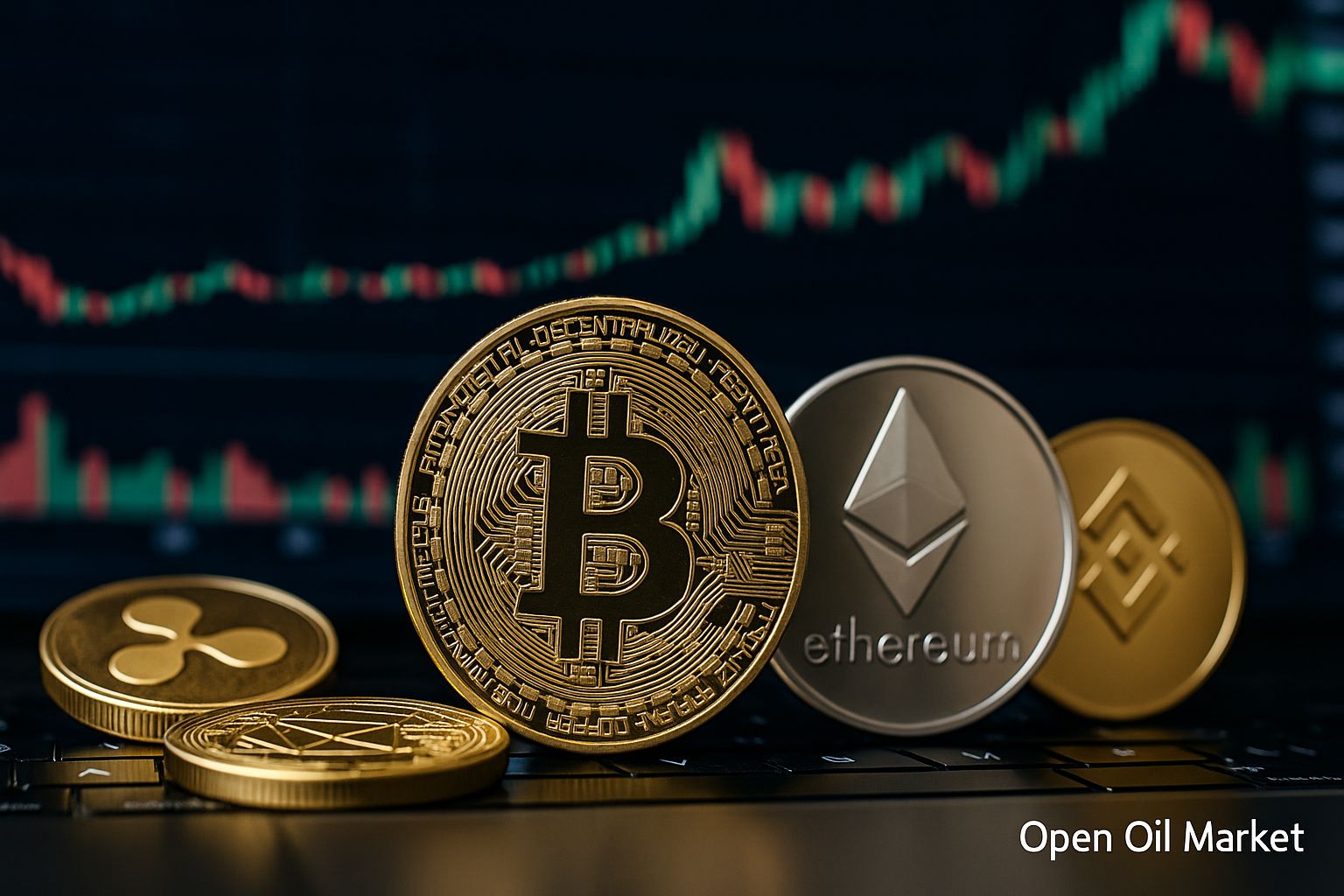
Cryptocurrency News, Monday, August 4, 2025 — The Crypto Market Remains Near Its Peaks; Ethereum Tests $4,000
The cryptocurrency market, at the start of Monday, August 4, 2025, remains close to its historical peak levels following an impressive rally over the past weeks, despite a slight correction at the end of the week. Bitcoin is trading near its record highs, while leading altcoins, spearheaded by Ethereum, continue to exhibit strength amid an influx of institutional investments and growing confidence in the sector. Below, we explore key news and trends in the cryptocurrency market as of August 4, 2025, that investors need to be aware of.
The Crypto Market Maintains High Positions
Global digital asset capitalization hovers around the record mark (approximately $3.8 trillion) following a recent spike in growth. The market is consolidating at reached levels with moderate volatility (although a brief downturn was observed at the end of last week due to signals from the U.S. Federal Reserve). The Crypto Fear & Greed Index remains in the 'greed' zone, reflecting the prevailing optimism among participants. Bitcoin's share accounts for around half of the total capitalization (~60%), which underscores the flagship's leadership role along with the significant contribution of altcoins to the current rally. Investment demand remains strong due to increased regulatory clarity in key markets and a sustained influx of institutional capital into the sector.
Bitcoin Consolidates Near Record Highs
Bitcoin (BTC), the largest cryptocurrency, reached around $125,000 last week after a surge, exceeding its previous historical peak (~$123,000). Currently, BTC is trading slightly below that peak (around $115–118,000), demonstrating resilient momentum even at such elevated price levels. A brief profit-taking at the end of the week, which briefly dropped the price below $115,000 (amid the absence of signals for rate cuts at the FOMC meeting), quickly attracted new buyers. This indicates sustained high demand: major players are purchasing dips, supporting the market. This significant increase in Bitcoin’s value in 2025 has been driven by two key factors: the influx of institutional investments through spot crypto ETFs and the limited supply of coins (due to the halving effect in 2024). New opportunities are emerging for Bitcoin. A number of analysts continue to forecast a price increase to $150,000 by year-end (with some bold estimates reaching $200,000), although volatility remains high. Any serious economic or political disruptions could trigger a correction. Nevertheless, the underlying fundamentals remain positive, and many investors adhere to a buy-the-dip strategy, anticipating further long-term growth for BTC.
Ethereum and Altcoins: Growth Continues
Ethereum (ETH), the second-largest cryptocurrency by market capitalization, has shown robust growth. The price of ETH is nearing the psychological barrier of $4,000 (a peak in recent years) and is attempting to break through resistance at this level. The dynamics of Ethereum are positively influenced by successes in the decentralized finance (DeFi) ecosystem and the high popularity of NFT tokens, as well as ongoing technical improvements to the network (enhancements in scalability and efficiency). Institutional interest is also expanding towards ETH: record amounts are being invested in Ethereum funds and ETFs, signaling strong confidence in the smart contract platform.
Among altcoins, XRP and BNB particularly stand out. XRP (the token of the Ripple payment network) remains around its multi-year highs, exceeding $3, receiving a significant boost after Ripple's legal victory over the SEC, which has provided regulatory clarity to the token. Binance Coin (BNB), the cryptocurrency of the largest exchange Binance, is trading at more than a year's highs (around $800) — despite previous challenges faced by Binance, the token has set a new all-time high on the wave of the exchange's ecosystem expansion. Other major altcoins are also strengthening their positions. Cardano (ADA) is gradually growing as its blockchain platform develops; Solana (SOL) has recovered from the downturn of 2022, attracting investors again with high transaction speeds and network scalability. The popular meme coin Dogecoin (DOGE) remains on an upward trend, receiving additional momentum from rumors about integration into a major payment service. Stablecoins continue to play a crucial role in the ecosystem as a "safe haven": the largest among them — Tether (USDT) and USD Coin (USDC) — are still tightly pegged to the dollar at a ratio of 1:1 and are widely used by investors to preserve capital amid market fluctuations. Their combined market share has slightly decreased as other assets have risen, yet stablecoins remain fundamental liquidity tools in the crypto market.
Top 10 Most Popular Cryptocurrencies
Despite thousands of existing digital coins, investor focus remains on a few major assets. Below is the current list of the top 10 cryptocurrencies by market capitalization as of today:
- Bitcoin (BTC) — The first and largest cryptocurrency, often referred to as "digital gold." Bitcoin remains the key market benchmark and recently set a new price record, reinforcing its status as a reliable asset in the eyes of investors.
- Ethereum (ETH) — The second-largest cryptocurrency by market capitalization and the leading platform for smart contracts. Ethereum forms the backbone of most decentralized applications in DeFi and NFTs and continues to strengthen its position through the development of its ecosystem.
- XRP (XRP) — Token of the Ripple payment network for fast international transfers. XRP has significantly increased in price amid positive regulatory shifts and Ripple's legal victory, returning to levels unseen since 2018.
- Tether (USDT) — The largest stablecoin pegged to the U.S. dollar at a ratio of 1:1. USDT is widely used by traders to preserve value amid market volatility and is one of the main liquidity tools in crypto trading.
- Binance Coin (BNB) — The native cryptocurrency of Binance exchange and its blockchain ecosystem (BNB Chain). BNB is used to pay trading fees and participate in DeFi projects on the platform; its price has significantly risen alongside the expansion of the ecosystem and user base.
- USD Coin (USDC) — A popular dollar stablecoin issued by Circle and Coinbase. USDC is known for the transparency of its reserves and regulatory support, enhancing market trust in it.
- Cardano (ADA) — A cryptocurrency and blockchain platform developed based on scientific principles (formal methods, Proof-of-Stake algorithm). ADA consistently ranks among the top ten, attracting infrastructure developers and long-term investors, although its price remains below historical highs.
- Dogecoin (DOGE) — A well-known "meme cryptocurrency" originally created as a joke. With an active community and support from notable entrepreneurs, DOGE continues to be in demand and remains one of the largest digital assets by market capitalization.
- Solana (SOL) — A high-speed blockchain for scalable decentralized applications. Solana has returned to the top ten, strengthening its position due to technical innovations and a resurgence of investor trust after overcoming past challenges.
- TRON (TRX) — A platform for smart contracts and decentralized applications, particularly popular in Asia. The TRX token remains among the leaders largely due to its active use in stablecoin transactions and a wide range of service ecosystems.
Cryptocurrency Regulation: Global Progress
The regulatory environment surrounding digital assets continues to evolve around the world. Measures are being implemented in various jurisdictions aimed at integrating cryptocurrencies into the legal framework:
- USA: In the United States, a historic step has been taken — President Donald Trump signed the first federal law regulating stablecoins (the GENIUS Act). This act requires 100% reserve backing of issued stablecoins and regular reporting by issuers, providing legal clarity for the industry. After a series of legal defeats (including the Ripple case), the U.S. regulator (SEC) has softened its rhetoric and approved several initiatives. In July, the House of Representatives also passed a separate bill establishing rules for cryptocurrency exchanges and the digital asset market — an important step towards integrating the crypto market into a legal framework.
- European Union: In the EU, a comprehensive MiCA regulation has come into effect, introducing unified standards for cryptocurrency regulation across the EU. The new licensing and oversight regime ensures transparency in the operations of crypto companies and investor protection, steering capital inflows into legal channels and strengthening Europe’s position in the global crypto market.
- Asia: Approaches in Asian countries vary. Hong Kong launched a licensing regime for stablecoin issuers and cryptocurrency exchanges on August 1, offering liberal conditions for crypto businesses in a bid to become a regional hub. In contrast, Japan maintains strict restrictions on cryptocurrency operations. Regulators in other Asian and Middle Eastern countries are also gradually opening up to the industry, although the emphasis is on risk control and investor protection.
Despite varying reform paces, the overall trend is shifting towards legalization. The crypto industry is gradually emerging from the "gray zone" and gaining official recognition, which increases trust in the market from major financial players.
Institutional and Corporate Investors in the Market
Large institutional players continue to expand their presence in the crypto industry. Banks and investment firms are launching new products based on digital assets and offering clients cryptocurrency custody and management services. In 2025, several financial giants on Wall Street have filed applications for launching spot Bitcoin ETFs, while existing cryptocurrency funds are experiencing record capital inflows (including into Ethereum funds) amounting to billions of dollars — indicating sustained interest and trust from traditional investors.
Traditional exchanges and banks are also exploring the use of cryptocurrencies in transactions. For instance, Bank of America has publicly confirmed its interest in utilizing stablecoins to expedite international transfers. Corporations are not remaining on the sidelines: several public companies — from IT giants to retailers — are incorporating Bitcoin into their reserves or accepting cryptocurrency as payment. Such moves showcase the transformation of digital currencies from an experiment into a fully-fledged financial instrument. The arrival of "long money" from institutions and corporations strengthens market resilience, gradually reducing the impact of speculative surges on prices.
Mass Adoption of Cryptocurrencies: Growing Trust
2025 has marked a significant increase in mass adoption of cryptocurrencies. The number of market participants — both institutional and retail — has risen dramatically. Major companies are increasingly holding Bitcoin in their reserves, while banks and funds are launching products like crypto ETFs and custodial services, integrating digital assets into the traditional financial system. At the consumer level, an increasing number of retail businesses and online services are accepting cryptocurrency as payment; precedents of real estate transactions fully paid for in BTC or ETH are emerging.
According to analysts, the number of cryptocurrency owners worldwide has already exceeded 500 million people — double the amount from two years ago. The industry is maturing overall, though questions regarding security and volatility remain pertinent. Nevertheless, digital assets are increasingly perceived as an integral part of the modern financial system, and the growing trust among a wider audience supports the long-term potential of the market.
Analysts' Forecasts and Risks
Sentiment in the cryptocurrency market remains predominantly optimistic, but experts urge investors to take a balanced approach. Bold price predictions are being made: some analysts expect Bitcoin to rise to $180–200,000, with Ethereum reaching $5–7,000 in the near future, based on the limited supply of BTC, the expansion of blockchain applications, and the emergence of clear "rules of the game" for the industry. However, risks persist. The cryptocurrency market remains volatile: sharp price downturns are common after rapid surges (as highlighted by the recent correction in early August). The legal environment remains unfavorable in several countries — with strict restrictions or discussions on new bans regarding crypto operations. In 2025, there has also been an increase in instances of hacking and fraud, underscoring the need for heightened attention to cybersecurity. Rational asset diversification and a long-term investment horizon remain the best defense for market participants amid potential turbulence.
Conclusions and Prospects
Historic steps towards cryptocurrency regulation and new price records signal a transition of the industry to a more mature stage, where digital assets are increasingly integrated into the global financial system. Bitcoin's record growth and capital influx into the sector bolster investor confidence in the market's long-term prospects.
The base scenario for the near future remains optimistic: in the absence of significant disruptions, Bitcoin and Ethereum will maintain their positions near their peaks, while investor capital will flow into the most promising altcoins, accelerating their growth. The increasing role of institutional investors entering this market should ensure that even corrections become more gradual. At the same time, the fast pace of industry development calls for a prudent approach from participants. Regulatory reforms create new opportunities, but it is crucial to adhere to established rules and maintain financial discipline. In the coming months, the community's attention will be focused on the further actions of lawmakers in key markets.
With moderate caution, diversification, and a long-term focus, the crypto industry stands a good chance of finishing 2025 on a high note, laying the groundwork for further growth in 2026.



